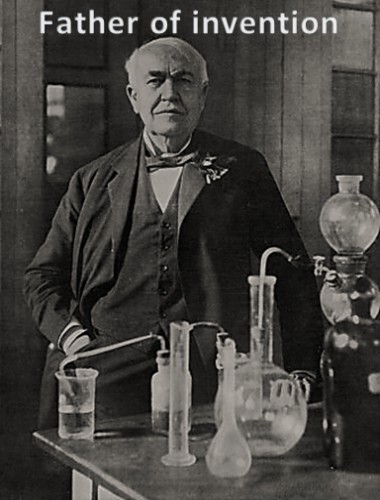Thomas Alva Edison inventions list:
1. The Phonograph: Thomas Edison’s first invention was the tin foil phonograph. While working to improve the efficiency of a telegraph transmitter, he noticed that the tape of the machine gave off a noise that resembled spoken words when played at a high speed. This led him to wonder if he could record a telephone message. In 1878, Thomas Edison established the Edison Speaking Phonograph Company to sell the new machine.
2. Light Bulb: Thomas Alva Edison’s greatest challenge was the development of a practical incandescent Electric Light Bulb. After a year of research, he conducts his first successful experiments with the light bulb in October 1879 using a carbon filament. It would burn in a vacuum in a glass bulb for 40 hours.
3. Motion Pictures: In the late 1880s, Edison began working on motion pictures. A member of his experimental staff, William Kennedy, Laurie Dickson played a key role in the development of the Kinetograph (a motion picture camera). In 1893, Edison demonstrates his system for making and showing motion pictures. In less than a decade, motion pictures become a popular and successful industry.
4. Electro-graphic Vote Recorder: Edison was 22 years old and working as a telegrapher when he filed his first patent for the Electro-graphic Vote Recorder. The device was made with the goal of helping legislators in the US Congress record their votes in a quicker fashion than the voice vote system.
5. Magnetic Iron Ore Separator:
Thomas Edison experimented during the 1880′s and 1890′s with using magnets to separate iron ore from low grade, unusable ores. His giant mine project in northwestern NJ consumed huge amounts of money as experimentation plodded forward. Engineering problems and a decline in the price of iron ore all lead this invention to be abandoned.6. Electric Pen:
In 1876, Thomas Edison invented the first electric copy machine to create copies of his notes. Using a small motor, the pen makes a tiny needle go up and down that produce a series of holes (50 per second) that are later gone over with a roller to press ink through the holes to create many copies of the document. Edison claimed that over 5000 copies could be made at once. This lesser known invention would not only be a precursor to the copy machine, but the tattoo pen as well.7. Carbon Transmitter:
Thomas Edison improved Alexander Graham Bell’s system with his carbon transmitter, by elongating how far apart phones could be. This invention used a battery and carbon to vary the resistance and control the strength of the current on the phone line. His design used a transmitter with lampblack carbon behind the diaphragm in the phone so that when sound waves moved it, they would also change the pressure on the carbon. He later improved by using granules made from coal instead and this basic design was commonly used until the 1980s.8. Automatic Telegraph:
Thomas Edison worked on automatic telegraphs between 1870 and 1874. The invention embossed special indents into a rotating cardboard disc with a needle powered by an electromagnet. It would then would form a recorded message that could be transmitted without an operator. Thomas Edison later invented the Quadruplex Telegraph to send two messages at the same time on the same wire and a Wireless Telegraph for radio communications between ships that worked using a vibrator magnet instead of a electromagnetic waves,